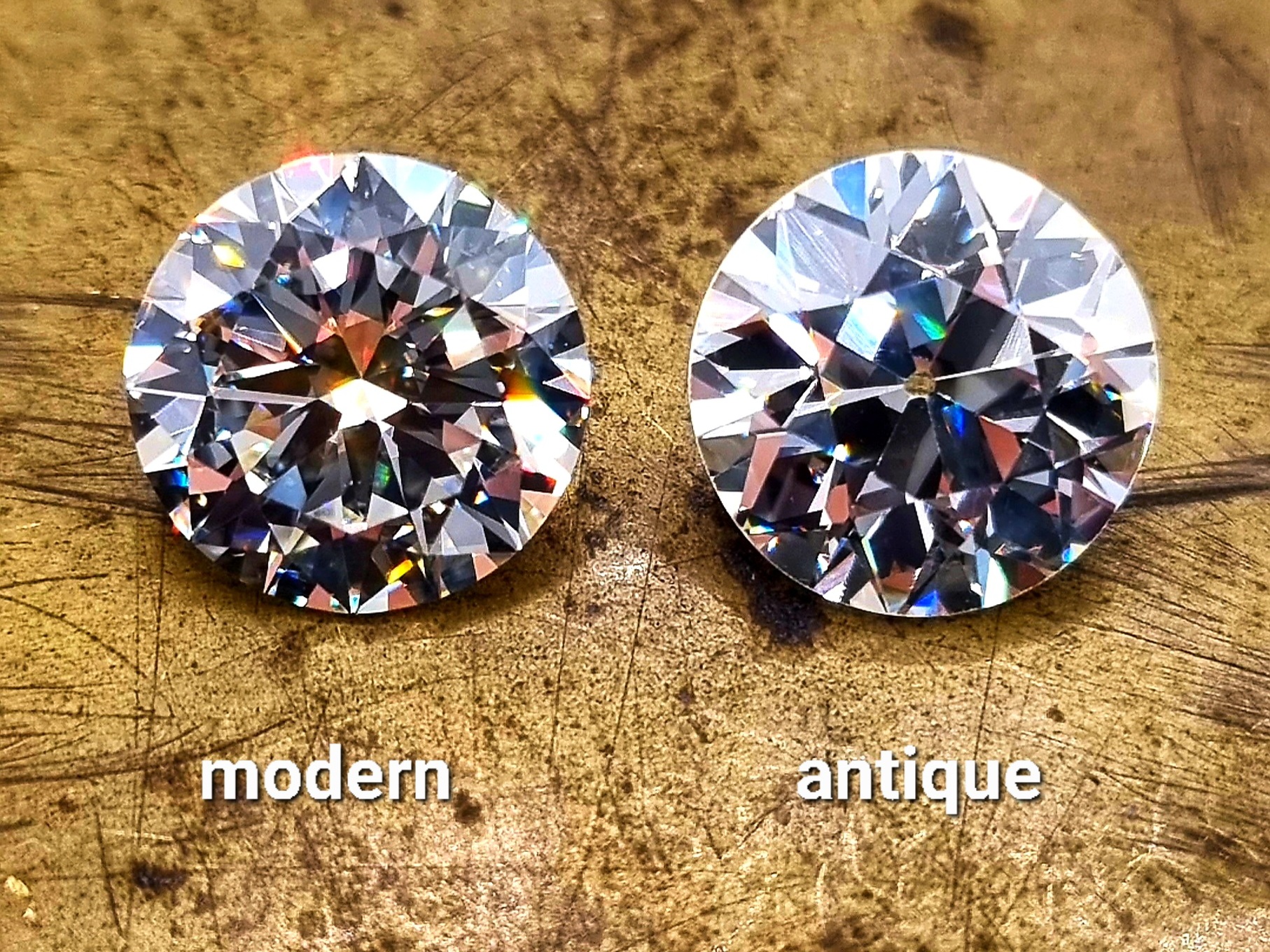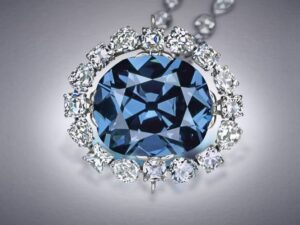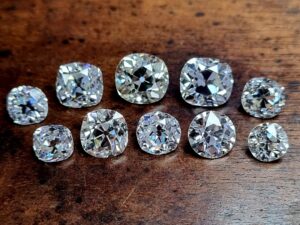Introduction
Embarking on the journey of identifying genuine antique diamonds is both intriguing and challenging. This article provides an insightful guide into the nuances of recognizing these historic gems. Covering aspects from the historical context and visual characteristics to expert consultations and common pitfalls, it equips collectors and enthusiasts with the knowledge needed to authenticate and appreciate the unique beauty and rich history of antique diamonds.
Table of Contents
Historical Context of Antique Diamonds
Understanding the historical context of antique diamonds is essential for anyone interested in their identification and appreciation. These diamonds, known for their distinct beauty and craftsmanship, have a storied history that intertwines with the evolution of diamond cutting techniques.
The Dawn of Diamond Cutting
The journey of diamond cutting, as detailed in “The History of Diamond: An In-Depth Guide,” reveals that antique diamonds hail from eras where cutting techniques were still developing. These periods saw the emergence of various cuts, each reflecting the technological and artistic capabilities of the time.
Prominent Antique Diamond Cuts
- Old Mine Cut: Explored in “The Old Mine Cut,” this style was predominant from the late 17th to the early 19th century. Characterized by its squarish shape with rounded corners, the Old Mine Cut features a high crown, a small table, and a large culet, distinguishing it from later cuts.
- Old European Cut: As discussed in “The Old European Cut,” this cut gained popularity in the late 19th and early 20th centuries. It served as a precursor to the modern round brilliant cut and is noted for its circular girdle, high crown, and small table.
- Antique Rose Cut: Discussed in detail in “The Antique Rose Cut”, these very old diamonds were first crated in the 16th century and precede the Old Mine Cut and the Old European Cut .

The Role of the 4 C’s in Antique Diamonds
While the 4 C’s—Cut, Color, Clarity, and Carat Weight—are modern grading standards, as outlined in “The 4 C’s and Antique Diamonds,” they offer valuable insights into antique diamonds. However, it’s crucial to understand that the criteria and expectations for these C’s were different in the past. For example, the emphasis on Cut in antique diamonds was more about enhancing the stone’s natural beauty rather than maximizing brilliance, as seen in modern cuts.
Transitioning to Modern Cuts
The shift from antique to modern diamond cuts was a gradual evolution, marked by advancements in cutting technology and a deeper understanding of light’s interaction with diamonds. This transition period is key to identify antique diamonds, which often exhibit characteristics distinct from those found in modern diamond cutting.
In summary, the historical context of antique diamonds provides a foundational understanding for their identification. Recognizing the characteristics of different historical periods and cuts, and understanding their place in the broader narrative of diamond cutting, is crucial for anyone looking to authenticate and appreciate an antique diamond.
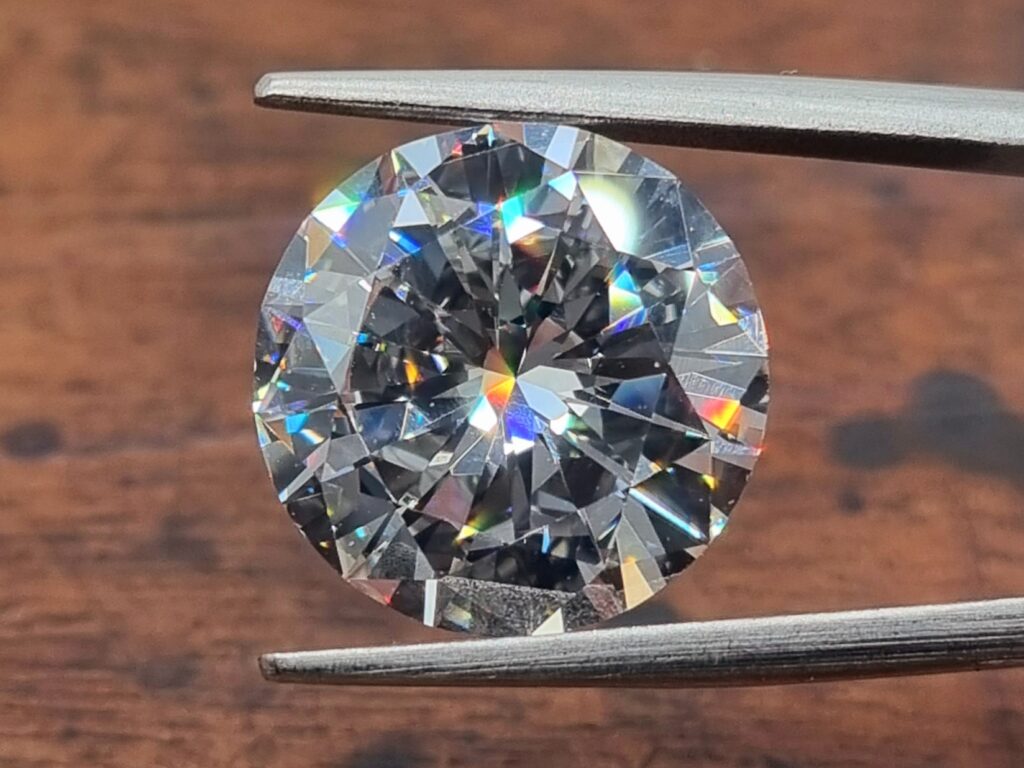
Visual Characteristics of Antique Diamonds
Distinctive Cut Styles
- Facet Patterns and Symmetry: Antique diamonds often have less precise symmetry and more varied facet patterns compared to modern cuts. The facets in cuts like the Old Mine and Old European are larger and less uniform, contributing to a softer, more diffused sparkle.
- Culet and Crown: Many antique diamonds feature a large, open culet and a higher crown, which impact how they interact with light. These features are particularly noticeable in cuts like the Old European Cut. For more information you can take a look at the article “Anatomy of a Diamond: Modern and Antique”.
Unique Shape and Proportions
- Shape Variations: Antique diamonds may have more irregular shapes, reflecting the hand-cutting techniques of their time.
- Proportions: Antique diamonds typically have deeper proportions, enhancing their visual appeal with a whiter appearance and increased luster.

Surface Wear and Patina
- Patina: Over time, antique diamonds develop a patina, a kind of ‘skin’ that can affect their luster. This patina is often considered desirable, adding to the diamond’s character and authenticity.
- Signs of Wear: Antique diamonds may show signs of wear, such as minor chips or scratches, indicative of their age and history.
Color and Clarity
- Color Variations: Antique diamonds can exhibit a range of colors, often with a warmer tone compared to the icy whiteness of many modern diamonds.
- Clarity Characteristics: Inclusions and blemishes in antique diamonds are not always viewed negatively; they can contribute to the stone’s story and uniqueness.
Reflective Qualities
- Brilliance and Fire: The reflective qualities of antique diamonds differ from modern cuts. They often have a more subtle brilliance and display a different kind of fire, which is less about sharp flashes and more about a gentle, romantic glow.
Understanding the visual characteristics of antique diamonds is crucial for collectors and enthusiasts. These features not only help in identifying genuine antique pieces but also in appreciating the artistry and history that each diamond embodies.
Tools and Techniques for Identification
Identifying genuine antique diamonds involves a blend of specialized tools and expert techniques. This section outlines the essential equipment and methods used by professionals and enthusiasts to authenticate these historic gems. It should be noted that extensive exposure to both modern and antique diamonds, essentially gaining experience, is arguably the most effective tool in identifying genuine antique diamonds.
Magnification Tools
- Jeweler’s Loupe and Microscope: Essential for examining antique diamonds, these tools allow for a detailed inspection of the cut, facets, and any inclusions or blemishes. They help in identifying the unique characteristics that distinguish antique diamonds from modern cuts.
Analyzing Cut and Facet Patterns
- Examining Symmetry and Style: A close observation of the symmetry and style of the cut and facets is essential. Antique diamonds often have larger, less uniform facets and a more hand-crafted appearance, unlike the precision of modern cuts. If you observe perfect symmetry, the stone is unlikely to be an antique cut, as achieving such precision wasn’t possible a hundred years ago. However, it’s important to note that the absence of symmetry doesn’t automatically indicate that a stone is antique either.
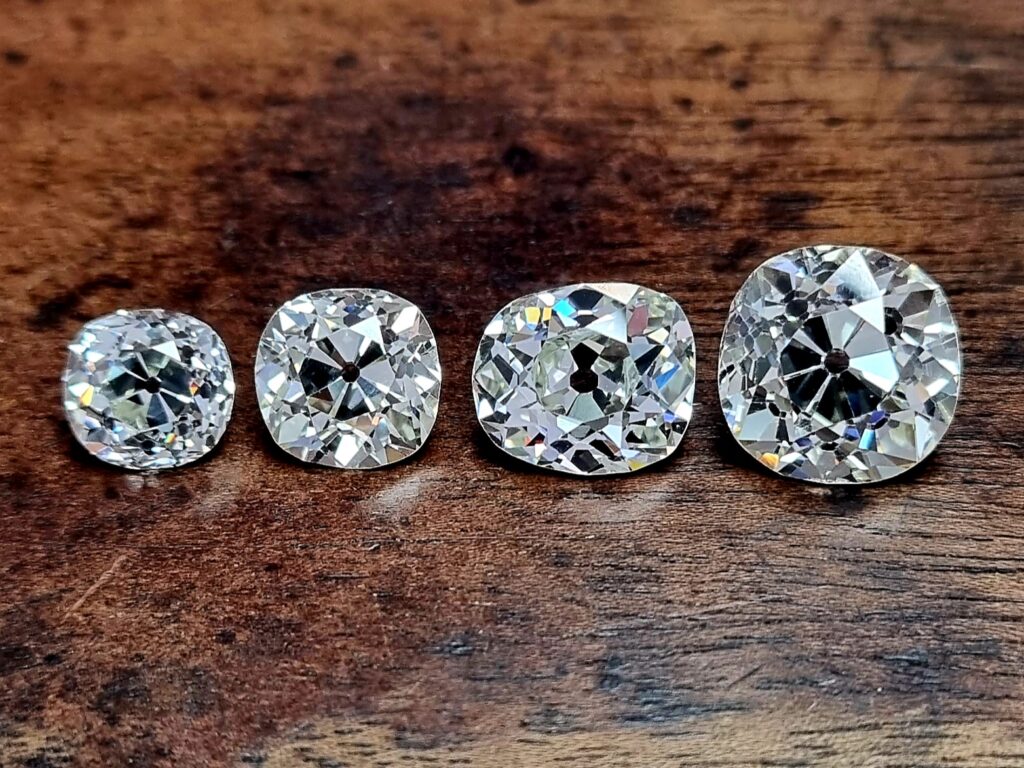
Assessing Surface Characteristics
- Patina and Signs of Wear: The presence of a natural patina and signs of wear, such as minor chips or scratches, can indicate that a diamond is an antique stone. These features, examined under magnification, provide clues about the diamond’s age and history. In antique diamonds, microscopic signs of wear are actually desirable. These signs, invisible to the naked eye, help confirm the diamond’s age. It’s worth noting that while these minor marks can be easily polished away, a practice common in the trade, doing so can detract from the diamond’s historical authenticity, which in my opinion, is a mistake.
Inspecting the Culet and Crown
- Culet and Crown Features: Many antique diamonds feature a large, open culet and a higher crown. These characteristics, different from modern diamond cuts, are key indicators of an antique diamond.
Color and Clarity Evaluation
- Assessing Color and Inclusions: The color of a diamond may not necessarily indicate whether it is antique. However, it’s interesting to note that antique-cut diamonds often appear whiter than their actual body color, a characteristic attributed to their unique proportions. Clarity, conversely, can be more indicative; Old Cut diamonds frequently exhibit inclusions, such as “feathers” around the girdle area, which can hint at their antique nature.
Historical Research and Comparison
- Using Historical References: Studying the typical features of diamonds from specific historical periods and comparing them with the diamond in question can aid in identification.
Seeking Professional Expertise
- Expert Gemological Analysis: For definitive authentication, consulting with a professional gemologist or a reputable appraisal service is recommended. They can provide expert analysis and certification, confirming the authenticity of an antique diamond.
The Role of Patina in Antique Diamonds
Understanding Patina in Antique Diamonds
The patina on antique diamonds is consequential in defining their character and authenticity. This natural aging process, marked by minute scratches and tiny chips, subtly changes the diamond’s surface, not really impacting its luster and overall appearance.
Patina is often a key indicator of a diamond’s age, providing tangible evidence of its journey through time. It serves as an important factor in authenticating antique pieces, distinguishing genuine antiques from newer replicas.
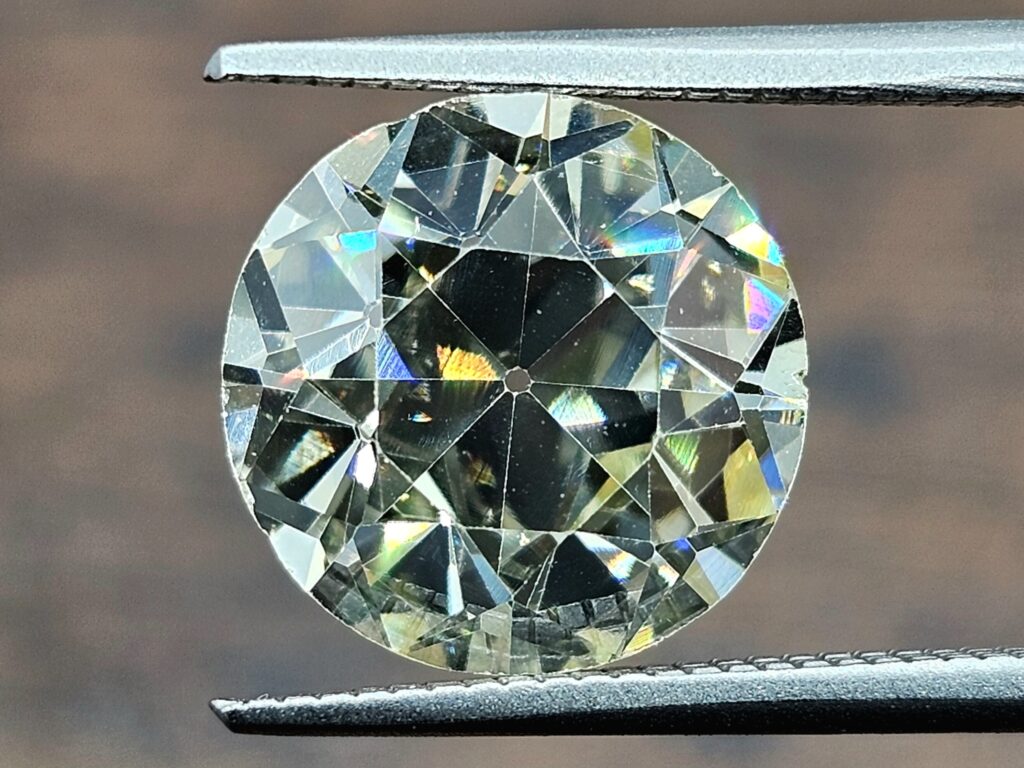
Patina vs. Damage
Distinguishing between patina and actual damage is essential. Patina consists of minor surface wear that doesn’t significantly impact the diamond’s integrity, whereas damage like deep chips or cracks can affect both the value and the structure of the diamond.
The Aesthetic Value of Patina
In the realm of antique diamonds, patina is often appreciated and sought after. It adds a level of historical context and depth that is highly valued by collectors and enthusiasts. Patina can enhance the character of an antique diamond, giving it a unique personality.
To Polish or to preserve?
The decision to polish a diamond and remove its patina is a matter of personal preference and debate among collectors. While polishing can restore a diamond’s original smooth surface, it may also strip away the historical essence that patina imparts.
Many experts and collectors advocate for preserving the patina, as it embodies the diamond’s history and journey through time. The role of patina in antique diamonds is a testament to their enduring beauty and historical significance, adding to their uniqueness and desirability.
Assessing the Provenance and Documentation
Most antique diamonds lack formal provenance documents, making it challenging to trace their exact origins. Often, clues about their provenance are gleaned from the jewelry settings they are found in and their physical characteristics. While purchasing from auctions might provide some insights into a diamond’s background, comprehensive provenance documentation is usually reserved for more famous and significant jewels. Consequently, assessing a stone’s age and authenticity often relies heavily on visual examination and expert analysis of its physical attributes.
Consulting with Gemological Experts
Choosing a Specialist
In the realm of antique diamonds, it’s recommended to consult with experts, particularly those specializing in antique jewelry. Their specific expertise is crucial for accurate authentication and appraisal.
These specialists possess in-depth knowledge of historical cuts and styles, vital for evaluating antique diamonds. Their expertise ensures precise identification and valuation.
The Consultation Process
Selecting a reputable expert with antique diamond experience is key. The consultation involves a thorough assessment, providing insights into the diamond’s quality and value.
Consulting with the right expert offers confidence and peace of mind in dealing with antique diamonds, ensuring an understanding of their true worth and history.
Common Pitfalls in Identifying Antique Diamonds
Misinterpreting Wear and Damage
One of the common mistakes in identifying antique diamonds is confusing natural patina and wear with significant damage. Understanding the difference is key, as patina often adds to the diamond’s value, while actual damage can detract from it.
Overlooking Modern Replicas
Another pitfall is failing to distinguish between genuine antique diamonds and modern replicas. Modern replicas may mimic the style of antique cuts but lack the historical authenticity and subtle characteristics of genuine antiques.
Assuming a GIA Report Will Confirm Antiquity
A common misconception is that a Gemological Institute of America (GIA) report (or any gemological lab) can always confirm if a diamond is antique. While GIA reports provide detailed information on a diamond’s characteristics, they will not specify or confirm its antique status, as this often requires additional historical and contextual analysis. It can be confusing as stones can be graded as “Old European Cut” or “Old Mine Cut” but this doesn’t mean the stone is actually old and refers to the cutting style.
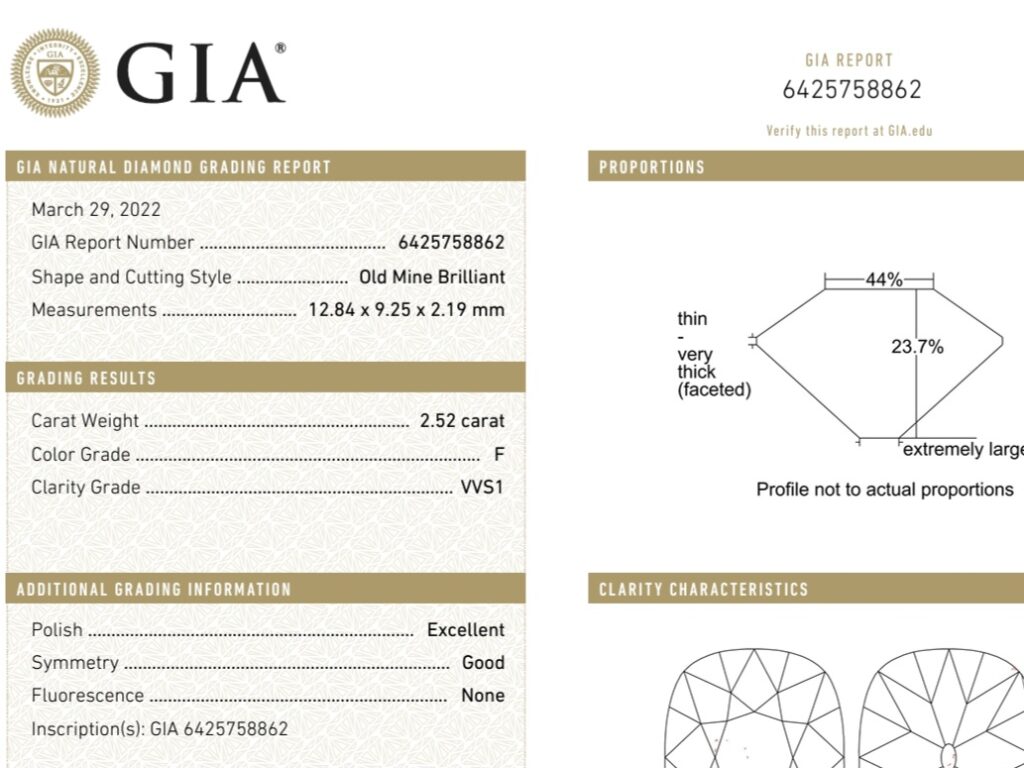
The term “Old Mine Brilliant” used by the Gemological Institute of America (GIA) can indeed be misleading, as it primarily refers to the shape and cutting style of a diamond rather than its age. For instance, this diamond, despite being labeled as an “Old Mine” by the GIA, is not an antique stone. It’s important to note that some antique-cut stones might be classified by the GIA under modern categories like “Cushion Brilliant” or “Cushion Modified Brilliant.” The GIA’s classification does not necessarily indicate whether a stone is an Old Cut. This highlights the importance of understanding that GIA reports focus on the diamond’s physical characteristics and do not explicitly confirm its historical period or antique status.
Relying Solely on Visual Inspection
While visual inspection is crucial, relying solely on it without expert consultation can lead to misidentification. Antique diamonds require a nuanced understanding of their unique features, which can be challenging for the untrained eye.
Assuming All Antique Diamonds Are Valuable
Not all antique diamonds hold high value. Their worth depends on various factors like cut, color, clarity, and historical significance. Assuming that age alone makes a diamond valuable is a common misconception.
Avoiding these pitfalls requires a careful and informed approach, combining visual inspection with expert knowledge and a deep understanding of antique diamonds’ historical and gemological aspects.
Conclusion
Identifying antique diamonds requires a blend of historical knowledge, expert input, and an eye for unique features. Awareness of common pitfalls and the importance of patina, provenance, and understanding gemological reports are crucial. This process is more than authentication; it’s a connection to the rich history and craftsmanship of each timeless gem.
Additional Resources
For a deeper exploration into the fascinating world of antique diamonds, consider the following resources:
Books on Antique Jewelry and Diamonds: Explore titles like “Diamonds: An Early History of the King of Gems” by Jack Ogden and “Estate Jewelry: 1760-1960” by Diana Sanders Cinamon for comprehensive knowledge about the history and characteristics of antique diamonds and antique jewellery .
Gemological Institute of America (GIA): GIA offers extensive resources and courses on diamond grading and identification, providing valuable information even though their reports don’t specify if a stone is an Old Cut.
Auction House Catalogs: Catalogs from auction houses like Sotheby’s and Christie’s often include detailed information about the diamonds they feature, serving as an educational tool for understanding antique diamonds.
Museum Collections: Visiting museums like the Victoria and Albert Museum in London or the Smithsonian in Washington, D.C., can offer a visual understanding of antique diamonds and their settings.
Professional Appraisers and Gemologists: For personalized insights and evaluations, consulting with professionals who specialize in antique jewelry can be incredibly informative.


